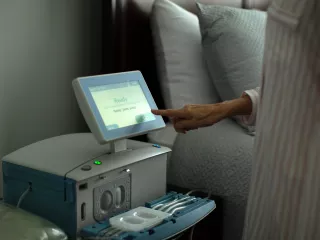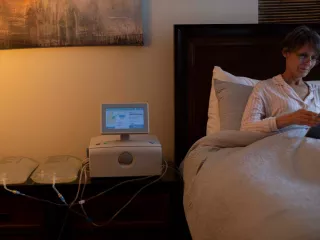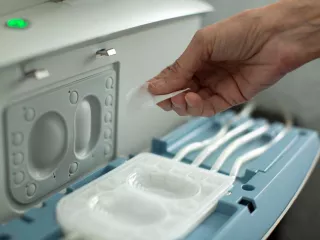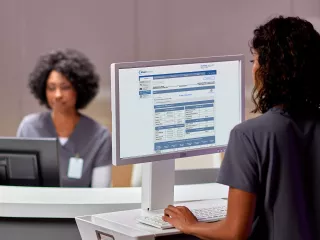
Amia APD System With Sharesource Connectivity Platform
Features: Learn how the Amia APD System can work for patients

Voice guidance
Simple, voice-guided, step-by-step instructions guide patients through details on how to set up and complete treatments.1 Built-in technical support features assist patients and, if necessary, provide contact information for help. The Amia system can speak to patients in English, Spanish or French Canadian.
The Amia system is the first and only peritoneal dialysis system in the U.S. equipped with voice guidance.1
Remote monitoring
The innovative Sharesource Connectivity Platform enables timely monitoring of patients’ historical treatment data. Sharesource Connectivity Platform establishes two-way connection between each patient’s Amia System and their clinic.2
Touchscreen interface
A large, intuitive touchscreen with graphics and animations guides patients through every step of their therapy, making it easy to learn and simple to perform.
Animation
Patients’ home PD therapy navigation is enhanced with simple, full-color animations. These are designed to help patients follow along with detailed steps, such as proper connect/disconnect procedures and aseptic technique.
Portability
The Amia system's compact size is designed for ease of use and storage at home. When patients are on the go, it can be packed in an optional convenient TSA-compliant carry-on case.1
Vantive offers a Global Travel Club to assist PD patients with travel. Visit PD Empowers to learn more.
SMART software
The SMART software on the Amia system includes advanced features that keep the patient's therapy within the programmed parameters.
- SMART Therapy: The Amia system may provide a more effective treatment than standard tidal therapy because with SMART Therapy, patients receive the benefits of tidal fills and drains while still receiving all of the prescribed total night therapy volume.1
- SMART Drain: If a drain alarm occurs during the night portion of therapy, the patient can activate a SMART Drain. This may allow a patient who experiences drain alarms while on therapy to complete the remainder of the night therapy.1
- SMART Dwells: If the SMART Dwells option is enabled by a clinician during programming, the Amia system will automatically adjust night dwell times for each cycle for the therapy to finish within the total night therapy time.3
Resources for patients and their caregivers

Support for the Amia APD System
The Amia System with Sharesource Connectivity Platform is backed by Vantive's industry-leading service and support.
Simple voice-guided instructions walk patients through each step of their treatment.1 The built-in Sharesource Connectivity Platform lets healthcare providers monitor historical treatment data remotely,2 which may reduce the number of visits patients need to make to the clinic.4
AmiaCare
Vantive’s AmiaCare service provides proactive or “predictive” maintenance to the Amia Automated PD System with the Sharesource Connectivity Platform. Under a predictive maintenance service model, routine service is performed prior to any failures or therapy interruptions to help improve the patient's experience.
Join us and stay informed
Stay up to date on the therapy and product innovations that matter most to you. Connect with a Vantive representative to find the right solutions for your organization.
Important Safety Information
Intended Use
The Amia Automated PD System is intended for automatic control of dialysate solution exchanges in the treatment of adult renal failure patients undergoing peritoneal dialysis. All therapies using the Amia Automated PD System must be prescribed and performed under the responsibility of a physician who is familiar and well informed about peritoneal dialysis.1
The Sharesource portal is intended for use by healthcare professionals to remotely communicate new or modified treatment parameters with compatible dialysis instruments and transfer completed treatment data to a central database to aid in the review, analysis, and evaluation of patients’ historical treatment results. This system is not intended to be a substitute for good clinical management practices, nor does its operation create decisions or treatment pathways.2
Rx Only. For safe and proper use of the products mentioned herein, please refer to the appropriate Operator’s Manual or Instructions for Use.
Vantive, Amia, and Sharesource are trademarks of Vantive Health LLC or its affiliates.
References
-
Vantive Health LLC. Amia Automated PD System Patient Guide.
-
Vantive Health LLC. Sharesource Connectivity Platform User Guide for Use with the Amia APD System.
-
Vantive Health LLC. Amia Automated PD System Clinician Guide.
-
Makhija D, Alscher MD, Becker S, et al. Remote monitoring of automated peritoneal dialysis patients: assessing clinical and economic value. Telemed J E Health. 2018;24(4):315-323.*
*Authors D. Makhija, J. Danek, T. Kudelka and M. Gellens are employees of Vantive Healthcare Corporation. Authors S. Laplante and J. Sloand were employees of Vantive Healthcare Corporation at the time of the study. Author K. McLeod is a consultant at Xcenda, funded by Vantive Healthcare Corporation to conduct the study. For all other authors, no competing financial interests exist.

